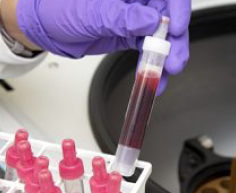Genomics front and centre in blood matching
The international Blood transfusion Genomics Consortium launches its programme to expand cutting-edge genomics for more accurate blood typing, leading to improved transfusion therapy and better patient care
Blood Centres from around the world have united to form an international collaboration, supported by our partner the NIHR BioResource and a genomic array provider, Thermo Fisher Scientific, to deliver a project which promises to make future blood transfusion therapy more efficient, more accurate, standardised, and safer.
These organisations are collaborating in the Blood transfusion Genomics Consortium, which is coordinated by Cambridge University Hospitals and brings together medical experts in the treatment of anaemia and other blood cell disorders, blood transfusion, computer science, population statistics and genomics.
The main aim of the Consortium in this age of genomic medicine, is to validate for clinical use an affordable single DNA-based blood typing test, pioneered in the NIHR BioResource studies 07 and 89 to improve the match between donors of blood and the patients who receive the blood transfusion.
By working collaboratively between 10 countries across 4 continents, the adaptation of this new approach based on genomics, which was developed by the Consortium will for the first time set international standards for testing and for the use of blood transfusion therapy with the ultimate goal to improve the safety and efficacy of blood transfusion for the millions of patients we serve.
Each year, millions of donations of blood provide life-saving treatment to patients all over the world. Transfusion is essential to save the lives of patients with major bleeding (e.g. trauma), to treat patients whose blood production is impaired or reduced by chemotherapy (e.g. cancer), and to treat patients with inherited anemia who do not make sufficient haemoglobin of the healthy type (e.g. sickle cell disease).
Red blood cells have molecules on their surface called antigens which are inherited and differ between individuals. Current practice is to match blood for transfusion according to the patient’s major ABO and Rh blood groups, for which donor blood is currently tested. Antigens of the many other blood groups are not routinely matched unless the patient has a reaction, because the current tests are too expensive. Hence mismatches between the transfused donated cells and the cells of the patient’s not infrequently occur. For some, this can cause life-threatening reactions in which the transfused cells are rapidly destroyed by the immune system (antibodies) of the patient.
Dr Gleadall from Cambridge University Hospitals and NHS Blood and Transplant said: “It is amazing to see how the long-standing collaboration between the NIHR BioResource and Thermo Fisher Scientific has resulted in the development of a new method for testing the genes for blood groups, HLA and HPA types which is cost-effective and can be applied to both patient and donor blood samples”.
Blood types are determined by approximately 40 different genes. Consequently, DNA taken from a blood sample can be tested to determine the complete (more than ABO and Rh) blood type profile. The same test also allows us to rapidly type other tissue (HLA) and platelet (HPA) groups, which can help identify the best matched platelets to give to patients.
Dr Connie Westhoff from the New York Blood Center commented: “After decades of research we are now on the cusp of introducing a cutting-edge genomic technology into routine practice. This is an exciting development and will make it possible to find compatible blood for the many patients requiring regular transfusions, particularly those with sickle cell disease”.
Using samples from 8,000 blood donors, the results from the newly designed test have been compared with those of tests currently used by blood services and excellent agreement (99.9% concordance) was observed. Of note, almost halve of the small number (73) of differences were caused by record entry errors in the results for the currently used tests.
Professor Ellen van der Schoot from the Sanquin Blood Supply Foundation in the Netherlands said: “What is really exciting is that this new test results in a 10-fold increase in the number of available antigen types and is easy to implement allowing for its wide use. With data from patients with complex antibodies it has been shown that this increased typing information makes it more likely that a donation for safe transfusion can be identified. Indeed when the results of the new test obtained with the samples of 3,000 Dutch donors became available, Sanquin was able to provide life-saving transfusions to a young female patient for whom compatible blood could not be identified before”.
To bring this precision medicine test to the bedside, operational validation and regulatory acceptance is required. To deliver this the Consortium researchers have developed a well-defined study protocol with precise timelines for delivery. By using the samples and antigen typing data of almost 100,000 blood donors from the seven blood services collaborating in this study, it is anticipated that industry acceptance and regulatory approval can be completed over a 24-month period. Once validated, the test will be used to support clinical trials at hospitals supported by the seven blood services participating in the Consortium, in anticipation of introduction of the test platform internationally.
The Consortium participants hope to open up broader national and international access to a new generation of blood type analyses using genomic technologies to improve patient care around the globe. Organisations interested in joining are advised to visit the Consortium’s website at www.bgc.io to look whether they qualify as possible future Members of the Consortium.



